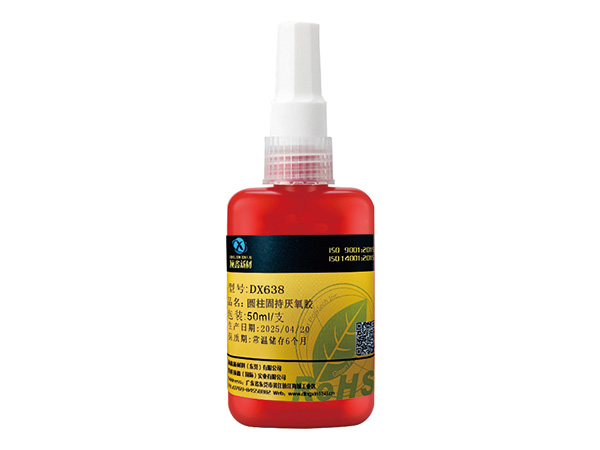Product Introduction
DX638 Has the following product characteristics:
| technology |
Acrylic acid |
| Chemical type |
Polyurethane acrylic ester |
| Appearance (uncured) |
Green liquid |
| Composition |
Single component - no need to mix |
| Viscosity |
tall |
| Curing method |
Anaerobic accelerator |
| Advantages of solidification |
Room temperature curing |
| Adhesive gap |
≤0.25mm |
The DX638 product design is applied to the bonding operation of cylindrical assembly parts. It solidifies when isolated from air between two closely fitting metal surfaces, and can prevent loosening and leakage caused by impact and vibration. The curing performance. This product is not only suitable for active metal surfaces (such as low-carbon steel), but also for less active metal surfaces, such as stainless steel or coated surfaces. This product has high temperature resistance and oil tolerance. It is suitable for surfaces with various minor contaminations, such as cutting, lubrication, anti-corrosion, and surfaces soaked in protective fluids. Typical applications include locking bushings and sleeves onto the housing and shaft.
Material properties before curing:
Specific gravity@ 25 °C:1.1
Flash point - see MSDS
Viscosity(mPa.s)(Brookfield RVT)
@25°C, CP52, 50rpm:1500 - 3000
Typical properties of cured material:
Physical characteristics:
| Thermal expansion coefficient, K |
80×10 |
| thermal conductivity, W/(m ·K) |
0.1 |
| specific heat, kJ/(kg ·K) |
0.3 |
Thermal expansion coefficient, K
Tg below
Tg the above |
95×10
192×10 |
Material properties after curing:
Adhesive performance
Curing at 25 ℃ for 72 hours
Compressive shear strength:
Steel shaft and sleeve, N/mm: ≥ 29.0
Usage
Assembly
1. To achieve the best results, thoroughly clean the inner and outer surfaces of the material with cleaning agents such as Loctite, and wait for the surface to dry before proceeding to the next step.
2. When the curing speed is slow or the gap is large, accelerators can be used on the surface to accelerate the curing speed.
3. For slip fit, simply apply a circle of adhesive around the guide angle of the shaft and sleeve, and rotate during assembly to ensure good coating.
4. For press fit, both bonded surfaces need to be coated with adhesive and assembled under appropriate high pressure.
5. For shrink fit components, the adhesive should be applied to the parts to form a smooth, uniform film. For hot fitting, the adhesive should be applied to the shaft. For cold fitting, the adhesive should be applied to the shaft sleeve. For cold and hot coordination, glue should be applied to the cooled components. Avoid condensation on cooled components.
6. Do not interfere with the components until they have reached sufficient operational strength.
Dismantling
1. Use manual tools to disassemble.
If necessary, locally heat the assembly to 250 ℃. Disassemble during heating.
3. When the temperature cannot be reached, try to heat the assembly parts as much as possible and use mechanical auxiliary equipment for disassembly operations.
Storage conditions
This product should be stored in a dry and cool place, with an ideal storage temperature of 18-26 ℃.
To avoid contaminating unused adhesive, do not pour the poured adhesive back into the original packaging container.
Keep away from children.
Precautions:
This product is not suitable for use in pure oxygen and/or oxygen rich environments, and cannot be used as a sealing material for chlorine gas or other strongly oxidizing substances. To prevent children from coming into contact with the product, please refer to the Material Safety Data Sheet (MSDS) for information on safe operation of this product. When using cleaning agents to clean the surface of materials, the compatibility between the cleaning agent and the adhesive should be checked. In some cases, the cleaning agents used may affect the curing and performance of the adhesive. This product is not recommended for use on plastics (especially thermoplastic plastics, which may cause cracking). It is recommended to test the compatibility of the product with the material before application.
Declaration: This manual is true and reliable. The data can only be used as a reference. We are not responsible for any results obtained by anyone using methods beyond our control. If the customer uses Usage not mentioned in this manual, the consequences shall be borne by the customer themselves. It is recommended that users conduct experiments based on the data provided in this article before formal use. Customers should be responsible for whether the product meets the usage requirements. Our company clearly declares that we are not responsible for any inevitable or accidental losses, including losses in terms of profits




